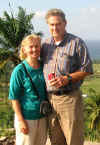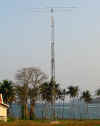Charles Lewis, S9SS

S9SS Caught in the Act of Polluting the Airwaves with QLF CW
 The
View from Our Veranda
The
View from Our Veranda Lesley
& Charles
Lesley
& CharlesI was born on February 14, 1942 in the small town of Lumberton in the
southeastern part of the the State of North Carolina in the USA. My ancestry is mostly English. As well as I can determine, my ancestors
immigrated to America in the 18th century. Up to the time of my childhood, my relatives were mostly farmers. I did not grow up on a
farm, but I worked on the tobacco farms of my relatives during summers when I was a child.
Using money I earned by working on farms in the summer, I obtained my first short
wave receiver, a Hallicrafters S53-A, when I was 12 years old and became an avid short wave listener.
Through short wave listening, I became interested in amateur radio. I was first licensed as a Novice with the call sign KN4OVA in 1956. A
year later my call sign became K4OVA when I upgraded. Some time during the '80s I upgraded to the FCC EXtra Class License and received the
call sign KY4P.
I have a BA degree from a small college in Western North Carolina, but I am self
educated in my profession as a radio broadcasting engineer. I have worked full time in radio broadcasting
since 1965, with the exception of a period of three and half years when I was a high school teacher. I served as chief engineer of many
North Carolina radio broadcasting stations during the period 1970 through 1989. I was also the corporate engineer for a group of
stations for some years during the '80s.
I joined the Voice of America as a Foreign Service radio engineer in 1989.I served in
Botswana for '89 to '92, Sao Tome '92 to '97, and Greece '97 to 2002. I returned to
Sao Tome on August 29, 2002. Over these years I have operated under the call signs A22AA, S92SS, SV0LM, SV5/SV0LM, A25/KY4P, and now S9SS.
I am currently the station manager of the IBB Sao Tome Transmitting Station (Voice of America). I am 60 years old and will retire in the
USA in 2007.
I enjoy operating CW more than SSB, but I have a handicap that makes it increasingly more difficult for me to send CW. In the
early 80's I fell from a high ladder while installing antennas on the roof of the studio building of a radio broadcasting station. I
suffered permanent cervical injuries that cause varying degrees of paralysis, spasms and numbness in my arms and fingers. As I have aged,
the problem has gradually worsened. I had to abandon the use of my paddle keyer a few years ago because my thumb had become too unruly
due to spasms. I returned to the use of a hand key for CW. I have seen a steady decline in the quality and speed of my sending with a hand
key, but I still enjoy working with a hand key. I do not find the use of a keyboard to send CW very satisfying; moreover, the same problems
that affect my ability to send well with a code key affect my typing on a keyboard. It is frustrating to me when I see comments of "QRS" or
"Very QRS" on the clusters. Those calling me start then to send at even slower speeds than I do. My stiff arm doesn't affect my ability
to copy code at a moderately high speed.
S9SS has nine bands capability, 160 through 10 meters. The main rig is an ancient Kenwood
TS-440SAT driving an equally ancient ETO Alpha 76PA linear. Most of the time, a Heathkit SA-2060A antenna tuner is in the lineup. The
antennas available are a 160/80 meters "T" with elevated radials, a Cushcraft R7 vertical, an extended double zepp for 17 meters, and a
HyGain TH-2 two element triband beam up about 17.5 meters.
Receiving conditions are often very difficult at S9SS. I live on a 347 acres international broadcasting site very close to high powered radio
broadcasting transmitters. A 600 kilowatt transmitter on 1530 kHz makes operation on 160 meters nearly impossible until it signs off
late in the evening. A full time 20 kilowatt transmitter on 945 kHz also generates enough wide band noise to degrade 160 meters reception
somewhat. Five 100 kilowatt short wave transmitters make operation impossible on some bands at various times of day due to overload,
spurious signals and noise bursts. Sometimes the onset of local QRM is unexpected, forcing me to QRT because I can no longer hear the
stations calling me.
The problems cited above are further exacerbated on 160 and 80 meters due to the almost constant high level of evening QRN here on the
Equator. When operating 160 meters, I am nearly always listening in S9 plus noise. I can usually hear only one signal at a time. It usually
takes an extended amount of time for me to assemble a complete call sign as a station repeatedly emerges briefly from the noise. I usually
need to hear the call sign many, many times before I can copy all of it. Stations that hear me give their partial call must come back to me
repeatedly until I acknowledge with the complete call and send an RST. Many have lost a 160 meters contact because they would give me only
one repeat of the call each time I sent "?" or "agn". Comments like "he is deaf" or "no receiver" on the DX clusters only serve to
discourage me from operating. I am doing the best I can in a situation where most operators would not even try.
I expect to be in Sao Tome for two, or possibly three, years. My XYL is Lesley, S9YL. So far she
has avoided pileups since we returned to Sao Tome. She might be willing to try some DX nets if you know of any that are good and that
are on at compatible times of day. Lesley was active on the "Butterfly Net" when we were here previously.
 Our
House (in the center) You can see how close we are to some of the HF
broadcasting antennas.
Our
House (in the center) You can see how close we are to some of the HF
broadcasting antennas.Lesley at Base of Baobab That Supports One End of 160 Meters Antenna
 The
S9SS TH-2 Beam
The
S9SS TH-2 Beam S9SS
Today
S9SS
Today
